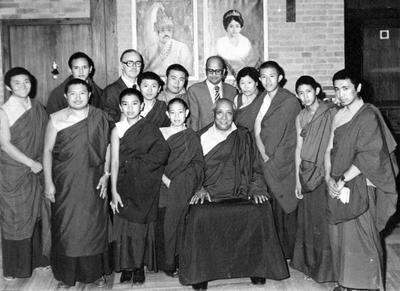 During the transmission of Chokgyur Lingpa's New Treasures in 1978 by Kyabje Dilgo Khyentse Rinpoche the owner of Yak & Yeti threw a dinner party in Kathmandu. Here we have a rare photo from those days of many of the tulkus you know very well nowadays.
During the transmission of Chokgyur Lingpa's New Treasures in 1978 by Kyabje Dilgo Khyentse Rinpoche the owner of Yak & Yeti threw a dinner party in Kathmandu. Here we have a rare photo from those days of many of the tulkus you know very well nowadays.Front row, from left: Tsikey Chokling, Dzogchen Jikmé Losal Wangpo, Shechen Rabjam, Kyabje Dilgo Khyentse, the lord of refuge, Rinpoches.
Back row, from left: Namdol Gyatso (general secretary at Ka-Nying Shedrub Ling), Orgyen Tobgyal, a diplomat, Chokyi Nyima, a Bhutanese tulku, Mr Saraf, Kunsang Dechen (Chokyi Nyima's mother), Dzongsar Khyentse, Dzigar Kongtrul, Pema Wangyal, Rinpoches.
18 comments:
That's quite a gathering. Great photo.
Great photo, thanks!!
I think its more correct that its Jikmé Losal Wangpo or Dzogchen Rinpoche, front row 2.
Golly, for just the teeniest of seconds I thought I was in a time warp - didn't we see this photo already? No matter - love those old photos.
:)
http://picasaweb.google.com/gyurmed88/Shechen
Thank you for sharing those photos, gyurmed.
Namaste.
Thanks but I'm not gyurmed, I'm you: anonymous!
http://www.youtube.com/watch?v=Mse1acS2xbU
http://www.e-sangha.com/dilgokhyentse/hh%20dilgo%20khyentse%20rinpoche.swf
Khandro Rinpoche in Norway, on doing Pilgrimage:
http://www.youtube.com/watch?v=1HMP_xVJFss
and
KTCDallas sangha organize a Pilgrimage to Guru Rinpoche Cave:
http://www.youtube.com/watch?v=41XfcJo51tI
Tibetan, Phayul, 24 hour radio/TV
Radio (mainly Tibetan songs):
http://www.phayul.com/onlineradio/
and
TV (Beta test phase, you can open the link in Windows Media Player menu: File - Open URL):
http://media.phayul.com/phayultv.asx
What is Ri-Me? by Ringu Tulku a student of Dilgo Khentse Rinpoche
http://www.youtube.com/watch?v=4kxd_VOH1aI
Rime, means non-sectarian. the Khyentse lineage has always encouraged people to be open-minded and study the various Buddhist lineages and traditions instead.
Ri-Mé_Approach, Ringu Tulku
Brussels June 6 2006
The Ri-Me Philosophy of Jamgon Kongtrul the Great: A Study of the Buddhist Lineages of Tibet by Ringu Tulku, ISBN 1-59030-286-9, Shambhala Publications
What is "Rimé"?
Ris or Phyog-ris in Tibetan means "one-sided", "partisan" or "sectarian". Med means "No". Ris-med (Wylie), or Rimé, therefore means "no sides", "non-partisan" or "non-sectarian". It does not mean "non-conformist" or "non-committal"; nor does it mean forming a new School or system that is different from the existing ones. A person who believes the Rimé way almost certainly follows one lineage as his or her main practice. He or she would not dissociate from the School in which he or she was raised. Kongtrul was raised in the Nyingma and Kagyu traditions; Khentse was reared in a strong Sakyapa tradition. They never failed to acknowledge their affiliation to their own Schools.
In the 1970's I was doing research work on the Rimé (Wylie, Ris-Med ) Movement. This gave me the opportunity to meet and interview a number of prominent Tibetan Lamas, including His Holiness, the Dalai Lama, and the heads of the four main Schools of Tibetan Buddhism. I prepared a questionnaire. One of the questions I asked was whether they believed that other Schools of Buddhism showed the way to attain Buddhahood. I have never been so rebuked in my life as when I asked that question! All of them, without exception, were shocked and felt insulted, deeply saddened that I, a monk, could ever have such doubts. They would not speak with me until I persuaded them to believe that this was one of those unimportant, procedural questions that are part of the modern University system.
"How can you say such a thing?" they rebuked me. "All Schools of Buddhism practise the teachings of the Lord Buddha. Moreover, the Schools of Buddhism in Tibet have even more common ground. They all base their main practice on Anuttara Tantra of Vajrayana. Madhyamika is their philosophy; they all base their monastic rules on the Sarvastivadin school of Vinaya.
One of the unique features of Buddhism has always been the acceptance that different paths are necessary for different types of people. Just as one medicine cannot cure all diseases, so one set of teachings cannot help all beings - this is the basic principle of Buddhism.
His Holiness, XIV Dalai Lama, has been strongly influenced by some great Rimé teachers such as Khunu Lama Tenzin Gyatso, Dilgo Khentse Rinpoche and the 3rd Dodrupchen Tenpe Nyima. Due to their efforts in recent years, there has been more interchange of teachings amongst different Schools of Tibetan Buddhism than ever before. Following the traditions of Rimé, the Dalai Lama has been receiving and giving teachings of all Schools in their respective traditions and lineages.
From the web: 'Tulku Yeshi Gyatso of the Sakya Monastery of Tibetan Buddhism has received teachings from 25 masters representing all five schools of Tibetan Buddhism.'
History of Tibetan Buddhism:
http://www.youtube.com/profile_videos?user=Goldenguru108
early footage of lamas after flight from Tibet in India:
Dilgo Khyentse Rinpoche
http://www.youtube.com/watch?v=8GpKLsQsog4
Mindroling Rinpoche & Karmapa
http://www.youtube.com/watch?v=Hl6AmPCQEBA
Dudjom Rinpoche (Dzongsar Khyentse's grandfather)
http://www.youtube.com/watch?v=2J9JH0RSBZc
Dzongsar Khyentse's maternal grandfather, great yogi Lama Sonam Zangpo
http://www.youtube.com/watch?v=J-kOuHkQErc
Photo of Tulku Urgyen Rinpoche
- Jetsün Khandro Rinpoche in Taiwan
- Part two
- Her Biography
- Trungpa Yangsi, flanked by confused westerners & Chinese, a heroic boddhisattva has returned.
- Not a fan of Krishnamurti, but see who's the young interviewer
Chokling Rinpoche is also there
Post a Comment